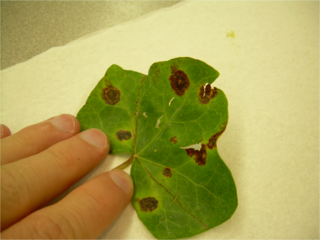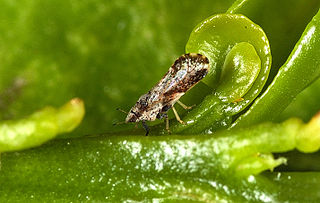
Psyllidae, the jumping plant lice or psyllids, are a family of small plant-feeding insects that tend to be very host-specific, i.e. each plant-louse species only feeds on one plant species (monophagous) or feeds on a few closely related plants (oligophagous). Together with aphids, phylloxerans, scale insects and whiteflies, they form the group called Sternorrhyncha, which is considered to be the most "primitive" group within the true bugs (Hemiptera). They have traditionally been considered a single family, Psyllidae, but recent classifications divide the group into a total of seven families; the present restricted definition still includes more than 70 genera in the Psyllidae. Psyllid fossils have been found from the Early Permian before the flowering plants evolved. The explosive diversification of the flowering plants in the Cretaceous was paralleled by a massive diversification of associated insects, and many of the morphological and metabolic characters that the flowering plants exhibit may have evolved as defenses against herbivorous insects.

Citrus greening disease is a disease of citrus caused by a vector-transmitted pathogen. The causative agents are motile bacteria, Candidatus Liberibacter spp. The disease is vectored and transmitted by the Asian citrus psyllid, Diaphorina citri, and the African citrus psyllid, Trioza erytreae, also known as the two-spotted citrus psyllid. It has also been shown to be graft-transmissible. Three different types of HLB are currently known: The heat-tolerant Asian form, and the heat-sensitive African and American forms. The disease was first described in 1929 and first reported in China in 1943. The African variation was first reported in 1947 in South Africa, where it is still widespread. Eventually, it affected the United States, reaching Florida in 2005. Within three years, it had spread to the majority of citrus farms. The rapid increase in this disease has threatened the citrus industry not only in Florida, but the entire US. As of 2009, 33 countries have reported HLB infection in their citrus crop.

Citrus canker is a disease affecting Citrus species caused by the bacterium Xanthomonas axonopodis. Infection causes lesions on the leaves, stems, and fruit of citrus trees, including lime, oranges, and grapefruit. While not harmful to humans, canker significantly affects the vitality of citrus trees, causing leaves and fruit to drop prematurely; a fruit infected with canker is safe to eat, but too unsightly to be sold.

Xanthomonas campestris is bacterial species that causes a variety of plant diseases, including "black rot" in cruciferous vegetables and bacterial wilt of turfgrass.

The beet leafhopper, also sometimes known as Neoaliturus tenellus, is a species of leafhopper which belongs to the family Cicadellidae in the order Hemiptera.
Alternaria citri is a fungal plant pathogen.

The Center for Information Technology Research in the Interest of Society and the Banatao Institute (CITRIS) is a research institute operated by the University of California to facilitate the real-world application of technological research. Approved in 2000, it is part of the Governor Gray Davis Institutes for Science and Innovation, along with the California Institute for Quantitative Biosciences, California Institute for Telecommunications and Information Technology, and the California Nanosystems Institute. Headquartered at UC Berkeley, CITRIS was founded in 2001 from a desire to see innovative technologies put to practical use in improving quality of life for people.
Proprioseiopsis is a genus of mites in the family Phytoseiidae.
Proprioseiopsis bay is a species of mite in the family Phytoseiidae.
Proprioseiopsis beatus is a species of mite in the family Phytoseiidae.
Proprioseiopsis dacus is a species of mite in the family Phytoseiidae.
Proprioseiopsis edbakeri is a species of mite in the family Phytoseiidae.
Proprioseiopsis exitus is a species of mite in the family Phytoseiidae.
Proprioseiopsis farallonicus is a species of mite in the family Phytoseiidae.
Proprioseiopsis ferratus is a species of mite in the family Phytoseiidae.
Proprioseiopsis latocavi is a species of mite in the family Phytoseiidae.

Diaphorina citri, the Asian citrus psyllid, is a sap-sucking, hemipteran bug in the family Liviidae. It is one of two confirmed vectors of citrus greening disease. It has a wide distribution in southern Asia and has spread to other citrus growing regions.

Clara Henriette Hasse was an American botanist whose research focused on plant pathology. She is known for identifying the cause of citrus canker, which was threatening crops in the Deep South.

Planococcus citri, commonly known as the citrus mealybug, is a species of mealybugs native to Asia. It has been introduced to the rest of the world, including Europe, the Americas, and Oceania, as an agricultural pest. It is associated with citrus, but it attacks a wide range of crop plants, ornamental plants, and wild flora.








